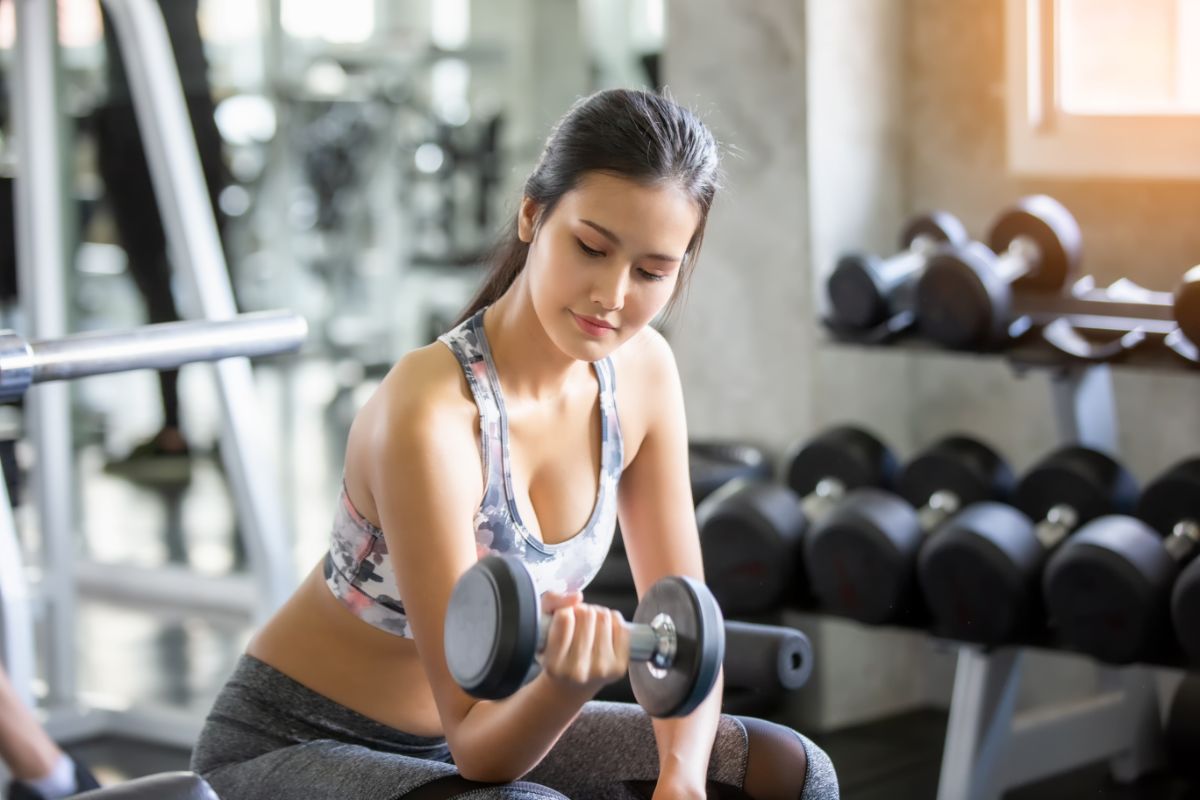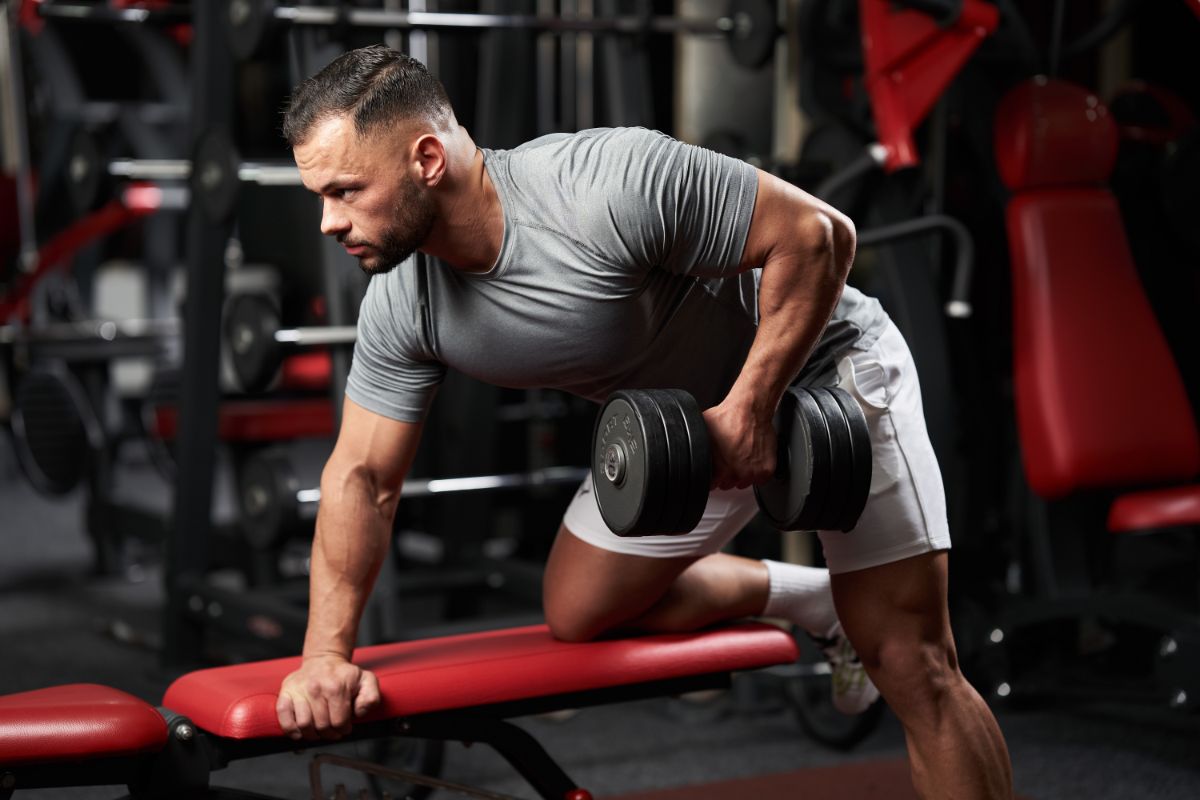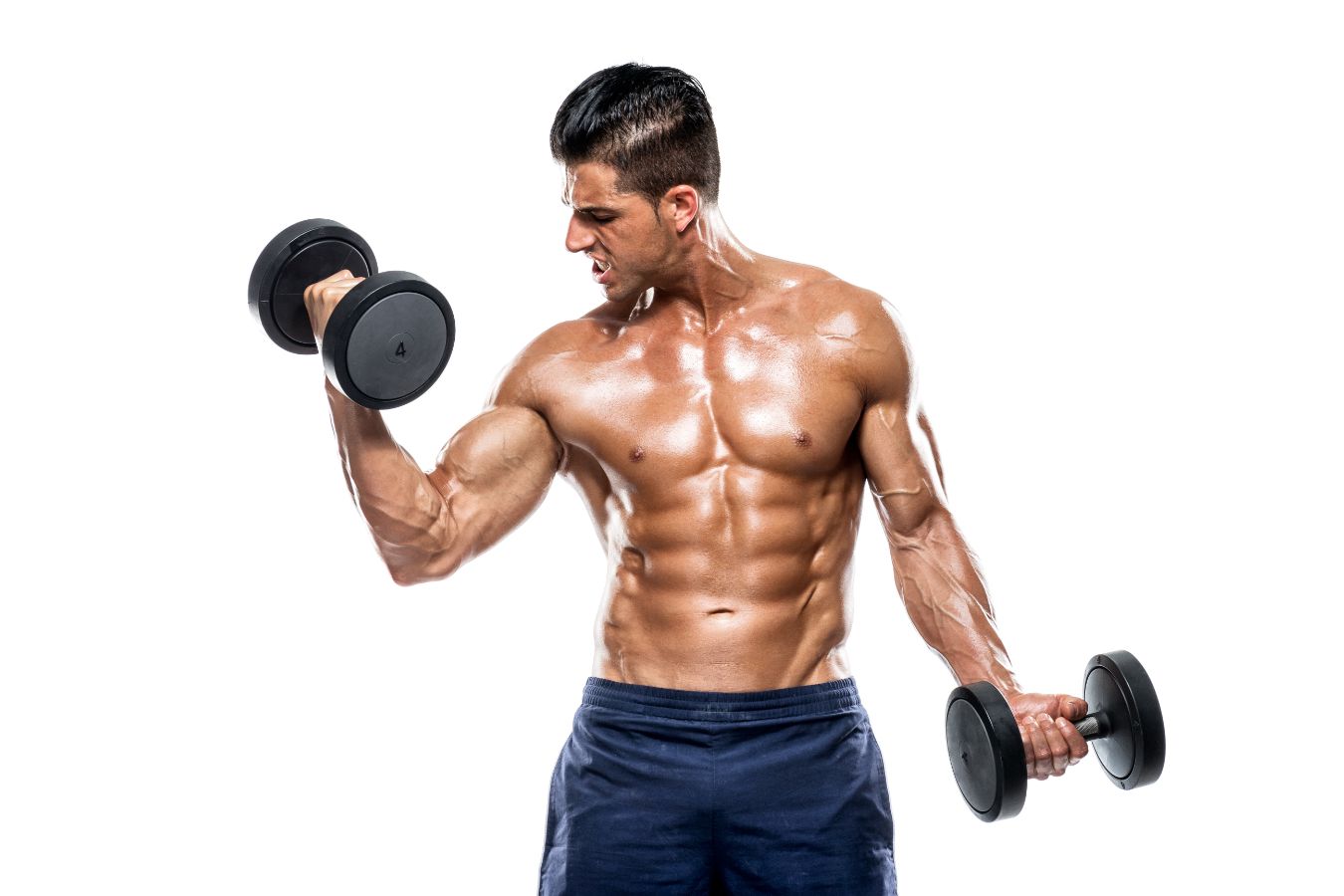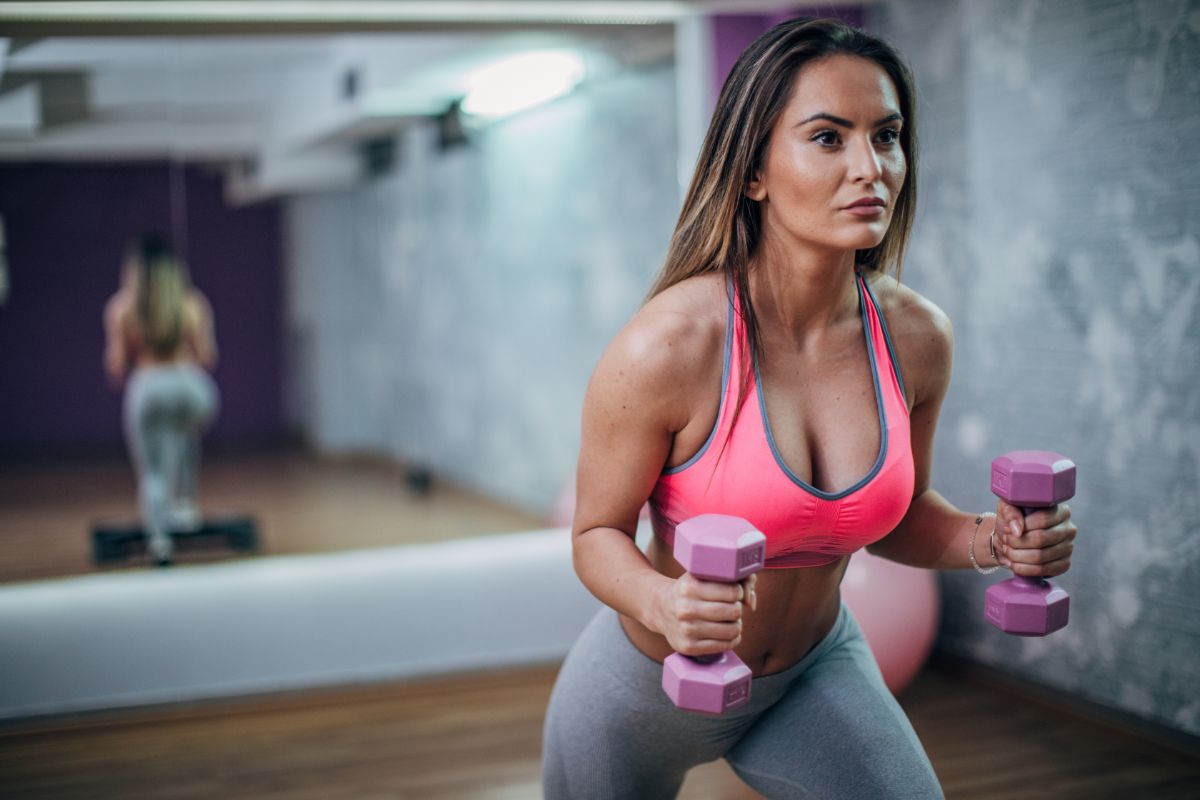Last Updated on December 13, 2022 by admin
Looking for the best dumbbell workouts to strengthen your back and biceps? Well, you’re in luck! Today, we’ll be breaking down the 10 best dumbbell workouts for your back and biceps that you can at home and in the gym.
These workouts are all about building strength and muscle mass in the heads of your biceps, your forearms, your latissimus dorsi (your lats), your lower back, and your rhomboids.
When done simultaneously, these exercises can not only make your muscles stronger, but help you build endurance in your biceps and back.
Exercising your back muscles and biceps together has long been a winning combination, and rowing exercises are a vital part of exercising both muscle groups.
A lot of row exercises are concentrated on back muscles, while your biceps and rear deltoid are essential synergistic muscles.
So whether you’ve just started weight training or are a well seasoned lifter, read on to discover the best dumbbell workouts for your back and biceps!
The Anatomy Of Biceps
The bicep muscle is made up of the biceps brachii and brachialis. The biceps brachii muscle is commonly known as the biceps, and is a thick, large muscle in your upper arm.
They are connected to the radius, which is a bone in the forearm. It starts at the scapula in two heads (the short head and the long head bicep), which is where the bicep gets its name.
The brachioradialis muscle group is attached firmly to the bicep and is activated when tracking your biceps and your back.
What Are Short Head And Long Head Biceps?
When we talk about bicep ‘heads’ we’re simply talking about the different attachment points in the muscle.
The short head and long head are also known as the inner and outer head respectively. The short head is found along the inner side of the anterior upper arm, while the long head is found along the outer side.
The long head is responsible for most of the biceps’ peak, while the short head is found on the inner side and is what makes the biceps wide. Both start at the scapula, but along distinctive points.
How To Develop The Short Head Of Biceps
Understanding how to distinguish between the two bicep heads when working out is essential for helping both heads reach their fullest potential.
The short head is a crucial muscle for building strength and mass. A short head that is well-developed is guaranteed to stand out, and training your short head is crucial when boosting the strength of your biceps.
There are a lot of exercises that concentrate on the short head of the bicep, and most of these you’re probably already aware of even if you may not have considered them as advantageous for your short head.
There are four main techniques you can use to enhance the short head bicep while training. These are:
- Curling with your elbows in front of your body.
- Curling with a wide grip.
- Curling with a supinated grip (i.e. your palm held out and facing upwards)
- Curling with your arms placed laterally towards your body.
The simple way to know if you’re working out the short head and long head of the biceps brachii is just to take a look in the mirror!
When using a close grip (which concentrates on the long head), then you will be able to see the long head. Meanwhile, when using a wide grip that concentrates on the short head, then you will be able to see it.
The Anatomy Of Back Muscles
The upper posterior chain (a fancy name for the back) has a large group of muscles that include:
Erector Spinae
These are muscles found in the spinal column, and these muscles help lumbar spine function such as bending and twisting.
Latissimus Dorsi
Also known as your lats, this is the biggest muscle of the upper body which helps you perform extension, adduction, and the horizontal abduction of the humerus.
Rhomboids
This is found under the traps and helps with scapular retraction.
Trapezius
These are muscles located near the neck that help with arm rotation, lateral flexion and neck rotation, scapular depression and retraction, and shoulder stabilization.
What Are The Advantages Of Back And Bicep Dumbbell Workouts?
- There are a lot of benefits to using dumbbells in back and bicep workouts, such as:
- Dumbbells require more balance than machines or barbells which may lead to better muscle fiber recruitment.
- Dumbbells are great for unilateral training, so you can train with a single dumbbell if you wish.
- It boosts stability in your core and corrects muscular inequalities.
- It gives you better joint stability and safety, and lets your joints move within their natural range of motion.
- Dumbbells make these workouts more varied, so you don’t get burned out or bored.
- Bicep and back dumbbell workouts give you variety and a better range of movement, which assists larger muscle fiber recruitment.
- Bicep and back dumbbell workouts are ideal for those who exercise at home and who don’t have a lot of space.
5 Best Dumbbell Exercises For Your Back
Dumbbell Bent Over Row
If you want to make your upper back stronger and add considerable muscle mass to your upper back, then we recommend dumbbell bent over rows.
The dumbbell row is a take on the barbell bent-over row that is easy to do at home with only two dumbbells.
Lifting the dumbbell up towards the chest focuses on the upper latissimus and trapezius. Pulling the dumbbell through a lower trajectory to touch the abdomen helps you focus the lower lats.
Muscles targeted
The main muscle focused on is the latissimus dorsi, while the secondary muscles are the erector spinae, rear delt, rhomboids, and trapezius.
Technique
Take a dumbbell in each hand and stand at a narrow stance. Bend your torso forward at a 45-degree angle to the floor, slightly bending your knees.
Rise up until the dumbbell touches your abdominal area, as this decreases contraction in your back muscles. Lower the dumbbell slowly to the starting position, remaining controlled.
Top tips
Don’t push yourself to use a weight you can’t handle. If the weight is too heavy it puts a strain on your spinal erectors and throws off your form. Always keep your movement controlled, and try to resist gravity trying to pull you down quicker!

Dumbbell Deadlift
This deadliest is the greatest exercise for strengthening posterior chain muscle, which includes the erector spinae, the glutes, and the hamstrings. You can do this exercise with just one barbell, one dumbbell, or two dumbbells.
One of the main advantages of using dumbbells is that you have more range of motion to work with. This would not be the case with barbell deadlifts.
Muscles Targeted
The main muscles worked are the erector spinae, the glutes, and the hamstrings. Other muscles targeted are the forearms, the lats, the quadriceps, and trapezius.
Technique
Grasp the dumbbells in each of your hands, keeping your back as straight as possible and remember to contract your hamstring and back.
Raise the dumbbell, focusing on your glutes and hamstrings. Remember to look up, keep your back straight, and your legs bent slightly.
Lift the dumbbells up so you’re standing up straight. Be careful not to overextend your body as the weight shifts to the lumbar spine. Hold the bar for a minute at the top of the lift and be aware of lockouts.
Slowly and gradually lower the dumbbell, bending your hips and then your knees. Allow the weight to almost touch the ground before you move onto the next rep.
Top tips
Make sure to finish the weight, rather than just lifting it halfway. If this is done inaccurately, it can have a negative effect.
Make sure to keep your back straight, maintain the accurate form, and to go through the full ROM (Range of Motion). It’s important that your movements are controlled and smooth.
Dumbbell Upright Row
This is a compound exercise that focuses on the muscles in your upper back and shoulders.
This exercise is a great one for building trapezius muscles and creating a distinct deltopectoral separation, while upright rows and shrugs with dumbbells are ideal for building huge traps.
If you just have one dumbbell, a single arm upright row is still an option.
Muscles Targeted
The main muscles worked are lateral deltoid and traps. Other muscles worked are the anterior deltoid, infraspinatus, and supraspinatus.
Technique
Grab two dumbbells and stand with your feet as wide as your shoulders and hips, bending your knees slowly. Keeping the dumbbell close to your body, gradually pull the dumbbells up to your lower chest.
Stop for a moment at the top and contract the muscles before lowering the dumbbell in a controlled manner until you return to your starting position. Repeat as needed.
Top tips
Remember to keep your back straight and your elbows above your forearms. To avoid your movements being too jerky, remember to stay controlled.
One-Arm Dumbbell Row
This is an amazing full-range exercise that strengthens your lats. It’s an ideal form of exercise if you have just one dumbbell. This allows you to focus on each side which gives you a bigger range of motion and improved muscle isolation.
It is also a great alternative to barbell rows. This is one bicep and back dumbbell workout that you need in your exercise routine!
Muscles targeted
This workout is all about the lats, but it’s also beneficial for your biceps, rear deltoid, rhomboids, and trapezius.
Technique
Grab a dumbbell with your palms facing inwards. Place your other hand and knee on a bench, keeping your back straight and just about parallel to the floor.
Pull the dumbbell up towards your torso, lifting your elbow as high as you can. Lower the dumbbell as slowly as you can. You should feel a good stretch in your lats. Repeat this for the other side.
Top tips
For improved isolation, keep your movements controlled. You should also avoid hunching your back to prevent injury.
Renegade Row
Also known as the plank row, the renegade row is very similar to a dumbbell row and is meant to focus on the upper back. It is also designed to concentrate on the core, similar to a plank.
The renegade row is an exercise with many benefits. It tones your arms and back, targets your core, and puts your stability and balance to the test. It’s the ultimate exercise for strength training and is sure to give you a ripped back!
Muscles Targeted
This workout targets your anterior deltoid, chest and lats, as well as your supraspinatus.
Technique
Put two dumbbells on the floor in line with your shoulders. With your hands on the dumbbells, begin in the top position of a push-up.
Pull his right elbow back, lifting your dumbbell towards your chest, keeping the right elbow close to the torso, your abs tight, and your hips aligned.
Hold for one second at the top and bring the weight gradually to the starting position so you can repeat on the other side. Repeat as needed.

Top tips
Stand up straight from your ankles to your shoulders and do not jerk the dumbbell up. You should also do the same number of repetitions for your other arm.
5 Best Dumbbell Exercises For Your Biceps
Concentration Curl
This is the ideal exercise for developing a biceps peak. This workout should be an integral part of arm day. After all, who isn’t impressed by peaked biceps?
This workout can be done seated with a bent torso or standing with one dumbbell. Placing your upper arm on your though keeps your shoulder still and is a fantastic way to isolate your biceps.
Muscles targeted
Of course, the main muscles worked here are the biceps, but the brachialis, brachioradialis, and forearm are also worked.
Technique
Bend over at your torso with a dumbbell in your hand and place your opposite arm on your knee.
Curl your arms as much as you can and twist your wrist so that your little finger is below your thumb. Curl the dumbbell and return to the starting position and repeat as needed.
Top tips
When exerted, remember to breathe! While this exercise is about pushing yourself, remember to keep your form controlled.
Dumbbell Reverse Curl
This is a take on the standard bicep curl where you hold the dumbbell with your palms facing up in an overhand grip. The motion is similar, but the difference is in the grip.
This grip lets certain arm muscles – such as the brachioradialis and brachialis – be the main focus.
This exercise is carried out by contracting the biceps with your palms facing down with a barbell, dumbbells, or EZ-curl bar. This exercise allows for a full range of motion and stability. Another option is a reverse curl with just one dumbbell.
Muscles Targeted
The brachialis and biceps brachii are the main muscles targeted, but the anterior deltoid, brachioradialis and forearms get a workout too.
Technique
Stand up straight with your feet as wide as your shoulders. Grasp a dumbbell with an overhand grip. Make sure your arms are extended.
Keep your upper arms still and back straight, curling the weights up to your shoulders, making sure to breathe out. You should also make sure that only your forearms are moving.
Keep curling the dumbbells up until they reach your shoulders and your biceps are contracted fully. In one smooth motion – making sure to breathe in – go back to the starting position.
Top tips
The slow, eccentric phase of this routine helps to enhance mind-muscle connection and tension. Ensure you use weights that are suitable to you.
Hammer Curl
The hammer curl is a beloved weightlifting routine that focuses on the forearms and biceps. It differs from a standard bicep curl because of the neutral grip used as opposed to an underhand grip.
The hammer curl exercise is so beloved among weightlifters and bodybuilders alike because it helps to develop muscular strength and hypertrophy.
Muscles Targeted
The main muscles worked in this exercise are biceps, brachialis, and brachioradialis. However, the anterior deltoid and forearms are also worked in this exercise.
Technique
Stand with your feet as wide as your shoulders, bending your knees slightly. Take a pair of dumbbells in your hands with your palms facing upwards. Keep your elbows close to your body, and gradually curl the dumbbells towards your shoulders.
Stop for a second at the top of the lift, squeeze your biceps, then bring the weights down with control.
Top tips
Gradually lift and lower the dumbbells. Keep your strength under control, and don’t rely on gravity or momentum. You shouldn’t lean back as you lift the weight, nor should you lean forward as you bring the weights down.
Standing Dumbbell Curls
Also known as the alternate dumbbell curl and the one-arm dumbbell curl, this exercise targets the bicep muscles at the front of your upper arm and the muscles of the lower arm.
When you perform a standing arm curl, it creates strength in your upper arm and trains you in how to use your arm muscles accurately. The dumbbell curl is an ideal exercise for building mass.
Muscles Targeted
Of course, the main muscles focused on here are the biceps, with the anterior deltoid, brachialis, brachioradialis, and forearm also getting a work out.
Technique
Standing up straight with your feet as wide as your shoulders, grasp a pair of dumbbells at your side without them touching your body. Your palms should also be facing upwards and your elbows should be bent slightly.
You should feel the tension in your biceps. Gradually curl the dumbbells up as far as you can, then gradually bring the dumbbells back to the starting position.
Top tips
Make sure not to swing your body back as you curl up the weight, and make sure your dumbbells are not touching your body.

Zottman Curl
The Zottman curl is one of the greatest twists on the standard bicep curl. It concentrates on your forearms and biceps simultaneously. It capitalizes on different hand positions at different phases of the lift.
The regular curl is in the first phase of this exercise and concentrates on bicep strength. The second lowering phase is the dumbbell reverse curl, which lets you overload your forearms.
Muscles Targeted
The biceps are the main muscles targeted in this exercise, as well as the brachioradialis. The brachialis and forearms are also targeted here.
Technique
Hold a pair of dumbbells at your sides. Keep your palms turned upwards as you curl the weights, bringing them up to your shoulders, stopping at the top of the movement.
Gradually twist your grip, so now your palms are turned down. Gradually lower the dumbbells to the starting position with an overhand grip. When the dumbbells are near your thighs, turn your hands again as you return to the starting position.
Top tips: For optimal results, this exercise needs to be controlled and slow. You should also go for lighter weights and concentrate on your form.
How Many Reps And Sets Should You Do For Dumbbell Workouts For Your Back And Biceps?
Because the number of reps and sets you do for these exercises are dependent on your experience and fitness levels, so there really isn’t a right or wrong answer to this question.
However, below you’ll find a jumping off point, depending on your experience and the weight you like to lift.
If you’re a beginner, we recommend doing 10 sets a week of your chosen workout, 15 sets for intermediate lifters, and 20 sets for advanced lifters.
If you lift heavy weights, we recommend doing 6-8 reps of your chosen workout, 8-15 reps for a moderate weight, and 15-20 (or more) for a light weight.
Frequently Asked Questions
Can You Train Your Biceps And Back At The Same Time?
Yes, you can! In fact, working out your biceps and back simultaneously is a great way to develop mass. Many bodybuilders and fitness experts recommend training these muscle groups together.
What Is The Best Duration For A Bicep And Back Workout?
Truthfully, there isn’t an ideal duration for a biceps and back workout. However, a back and bicep workout routine usually lasts for about 45 to 90 minutes, which is ample.
Many people prefer quick workouts, while some like slow workouts, so how long your workout should last really does depend on your preference.
All the workouts we’ve mentioned are ideal bicep and back dumbbell workouts for exercise at home. Achieving big biceps and a striking, V-shaped back is all down to working out your biceps and back.
How Often Should You Train Your Biceps And Back?
Because the back is a group of many muscles, you’ll have to think strategically about working out these muscles, and they require a bit more attention than your biceps.
But really, how frequently you train your biceps and back depends on your fitness goals, your muscle mass, and your lifestyle.
So if you’re only able to hit the gym once a week, then you have to build up your volume. However, if you hit the gym twice a week, then simply exercise a muscle until you’re exhausted and move on.
Should You Start With The Biceps Or Back?
Large muscles should always be your first priority when working out small and large muscles simultaneously. This is because large muscles need more energy and strength. In this case, you should begin with the back.
Should You Superset The Back And Biceps?
Yes, you can do superset bicep and back workouts with dumbbells. Still, both muscles are similar as they are targeted when you adduct or pull something. This makes a superset challenging, but that doesn’t mean you can’t try!
Final Thoughts
We hope our article has given you some great dumbbell workouts you can incorporate into your exercise regime at home or in the gym to get a sharp, V-shaped back and bulging biceps!
It’s crucial that you perform these workouts accurately, not only to ensure your workouts are safe and not counterproductive, but so that you can see the best results.
Even if you have just one dumbbell at home, many of the exercises on this list are possible to do with a single dumbbell, and work just as well for a beginner as they do for an intermediate or advanced weight lifter!

